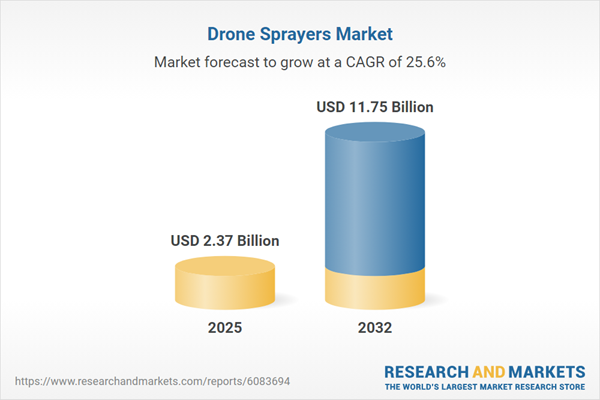Speak directly to the analyst to clarify any post sales queries you may have.
The Drone Sprayers Market is transforming global agricultural and environmental management practices, enabling efficient, precise, and sustainable crop treatment solutions for forward-thinking businesses and institutions.
Market Snapshot: Drone Sprayers Market Growth Trajectory
The Drone Sprayers Market grew from USD 1.89 billion in 2024 to USD 2.37 billion in 2025. The market is set to continue its strong expansion at a CAGR of 25.63%, ultimately expected to reach USD 11.75 billion by 2032. Favorable regulatory shifts, widespread validation of autonomous systems, and increasing integration of AI have established drone sprayers as proven solutions for both large-scale agriculture and specialized land management sectors. Demand is being fueled by efficiency imperatives and a focus on sustainable practices across regions, with technology adoption accelerating in both established and emerging markets.
Comprehensive Scope & Segmentation of the Drone Sprayers Market
- Application Areas: Crop spraying (aerial and foliar), disease monitoring (imaging-based and sensor-driven), fertilizer application (granular and liquid), herbicide application (post-emergent and pre-emergent), and pest control (insecticide spraying, rodenticide dispersion).
- Platform Types: Fixed-wing (delta wing, single-wing), hybrid VTOL (tail-sitter, tiltrotor), and multi-rotor systems (hexacopters, octocopters, quadcopters), designed for various payload and flight demands.
- End-User Verticals: Agriculture (large and small farms), forestry (natural forests, plantations), horticulture (greenhouses, nurseries), and turf and landscaping (golf courses, parks), supporting a wide range of operational scales.
- Propulsion Systems: Electric (battery-powered and solar-assisted), traditional fuel types (diesel, gasoline), and gas-electric hybrid models, each facilitating different performance or sustainability goals.
- Advanced Technologies: AI integration (computer vision, machine learning), autonomous flight (pre-programmed and real-time routes), GPS guidance (differential, RTK), manual control options, and swarm technology for coordinated deployment.
- Geographical Coverage: Americas (North America and Latin America), Europe, Middle East & Africa, and Asia-Pacific, encompassing major and emerging national markets.
- Leading Industry Players: Includes SZ DJI Technology Co., Ltd., Guangdong Xiaogang Agricultural Aviation Technology Co., Ltd., Yamaha Motor Co., Ltd., Parrot Drones SAS, AgEagle Aerial Systems, Inc., AeroVironment, Inc., Yuneec International Co., Ltd., Autel Robotics Co., Ltd., PrecisionHawk Inc., and Kespry, Inc.
Key Takeaways for Decision-Makers
- Drone sprayers are driving measurable improvements in resource utilization, reducing chemical application rates and environmental exposure while supporting regulatory compliance goals.
- The ecosystem is increasingly shaped by partnerships between hardware manufacturers, technology providers, service consultancies, and downstream users, resulting in tailored solutions for diverse agricultural and environmental sites.
- As digital agriculture matures, AI-enabled targeting, autonomous navigation, and seamless data integration are becoming essential features, supporting adaptive management and analytics-driven practices.
- Early adoption by large-scale operations has been mirrored by an uptick in smaller-scale and niche sector uptake, expanding the technology’s user base and support infrastructure.
- Diversification of propulsion, platform design, and application strategies is enabling operators to meet complex needs across a range of climatic, geographic, and regulatory environments.
- Broader alignment with sustainability and modernization objectives places drone sprayers as a central tool for progressive industry transformation.
Tariff Impact: Supply Chain and Procurement Adaptations
Recent United States tariff updates are prompting manufacturers to restructure supply chains, invest in local sourcing, and diversify procurement channels. Firms mitigating import cost volatility are better positioned to maintain pricing stability, while enhanced domestic component production is supporting new performance benchmarks. Service providers and end users are adjusting capital decisions to account for incremental cost changes, emphasizing flexible supply strategies and collaborative partnerships across the value chain.
Methodology & Data Sources
This market assessment is based on a robust combination of primary and secondary research, including targeted interviews with industry stakeholders, quantitative surveys spanning diverse user types and regions, analysis of published literature, and validation by independent experts. Case studies illustrate real-world performance, and data triangulation ensures actionable credibility.
Why This Report Matters
- Senior leaders gain insight into proven and emergent drone sprayer technologies, supporting informed capital allocation and operational planning.
- The analysis enables strategic benchmarking of product, regional, and supply chain trends, revealing pathways for competitive advantage and market entry.
- Detailed segmentation equips organizations to customize market approaches, optimize procurement, and respond to evolving regulatory and client requirements across regions.
Conclusion
The drone sprayer market’s dynamic evolution is delivering measurable value for both established and emerging participants. Informed action on technology, supply chain, and partnership strategies will shape long-term competitive positioning and growth.
Table of Contents
3. Executive Summary
4. Market Overview
7. Cumulative Impact of Artificial Intelligence 2025
Companies Mentioned
The companies profiled in this Drone Sprayers market report include:- SZ DJI Technology Co., Ltd.
- Guangdong Xiaogang Agricultural Aviation Technology Co., Ltd.
- Yamaha Motor Co., Ltd.
- Parrot Drones SAS
- AgEagle Aerial Systems, Inc.
- AeroVironment, Inc.
- Yuneec International Co., Ltd.
- Autel Robotics Co., Ltd.
- PrecisionHawk Inc.
- Kespry, Inc.
Table Information
| Report Attribute | Details |
|---|---|
| No. of Pages | 190 |
| Published | October 2025 |
| Forecast Period | 2025 - 2032 |
| Estimated Market Value ( USD | $ 2.37 Billion |
| Forecasted Market Value ( USD | $ 11.75 Billion |
| Compound Annual Growth Rate | 25.6% |
| Regions Covered | Global |
| No. of Companies Mentioned | 11 |









